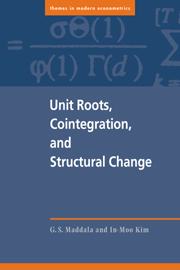Book contents
- Frontmatter
- Contents
- Figures
- Tables
- Dedication
- Preface
- Part I Introduction and basic concepts
- Part II Unit roots and cointegration
- Part III Extensions of the basic model
- Part IV Structural change
- 13 Structural change, unit roots, and cointegration
- 14 Outliers and unit roots
- 15 Regime switching models and structural time series models
- 16 Future directions
- Appendix 1 A brief guide to asymptotic theory
- Author index
- Subject index
14 - Outliers and unit roots
Published online by Cambridge University Press: 04 August 2010
- Frontmatter
- Contents
- Figures
- Tables
- Dedication
- Preface
- Part I Introduction and basic concepts
- Part II Unit roots and cointegration
- Part III Extensions of the basic model
- Part IV Structural change
- 13 Structural change, unit roots, and cointegration
- 14 Outliers and unit roots
- 15 Regime switching models and structural time series models
- 16 Future directions
- Appendix 1 A brief guide to asymptotic theory
- Author index
- Subject index
Summary
Introduction
In the preceding chapter we discussed the effects of structural breaks on unit root tests and cointegration tests. The breaks considered were breaks in trends, mostly one break and in a few cases multiple breaks. In this chapter we shall discuss another related problem, that of outliers. The structural breaks considered in the previous chapter correspond to one type of outliers.
There is a large amount of literature on outliers in time series, but this has had an impact on unit roots only in recent years. As Balke and Fomby (1991a, 1994) noted, there is considerable evidence of different types of outliers in macroeconomic time series. In this chapter we shall consider the different types of outliers and also outlier-robust unit root tests. Outlier-robust estimation methods for nonstationary time series will also be discussed briefly. Much of this material is covered in Maddala and Yin (1996) and Yin and Maddala (1996, 1997).
Different types of outliers in time series models
Outliers are aberrant observations that are away from the rest of the data. They can be caused by recording errors or unusual events such as changes in economic policies, wars, disasters, and so on, as for instance those considered by Perron (1989). They are also likely to occur if the errors have fat-tailed distributions (as is the case with financial time series). Outliers can also be caused by misspecification of the estimated relationships, e.g., linear instead of nonlinear relationships, omitted variables, and so on.
Information
- Type
- Chapter
- Information
- Unit Roots, Cointegration, and Structural Change , pp. 425 - 453Publisher: Cambridge University PressPrint publication year: 1999
Accessibility standard: Unknown
Why this information is here
This section outlines the accessibility features of this content - including support for screen readers, full keyboard navigation and high-contrast display options. This may not be relevant for you.Accessibility Information
- 1
- Cited by
